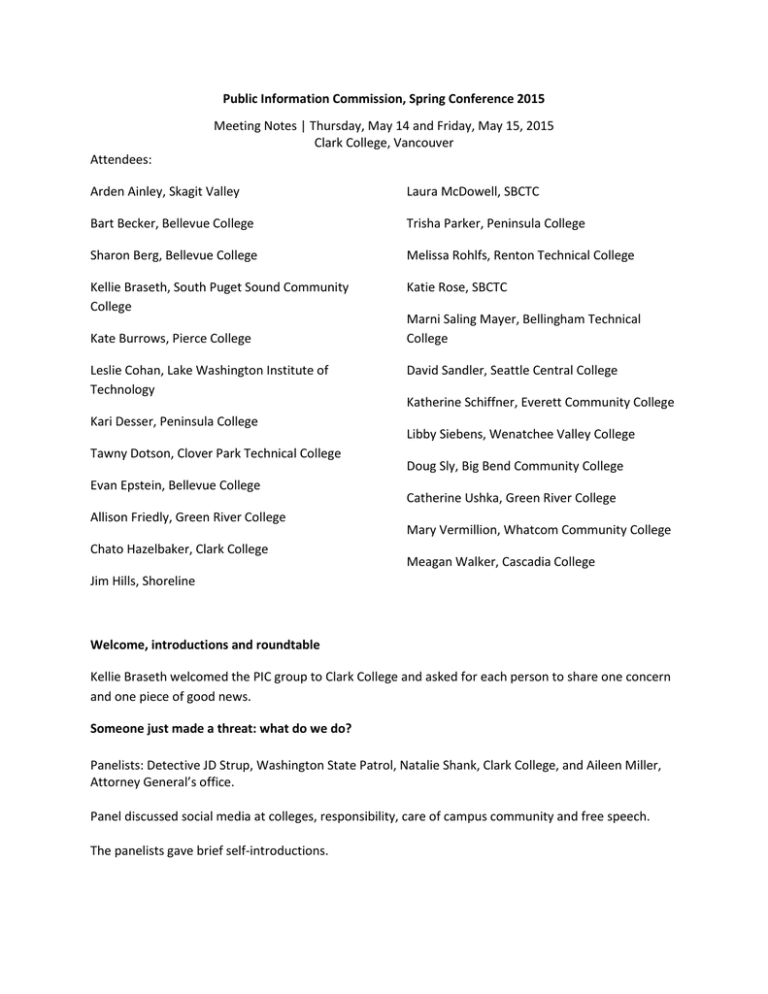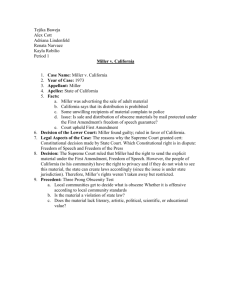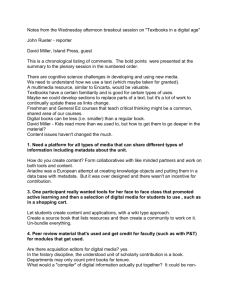Public Information Commission, Spring Conference 2015 Clark College, Vancouver Attendees:
advertisement

Public Information Commission, Spring Conference 2015 Meeting Notes | Thursday, May 14 and Friday, May 15, 2015 Clark College, Vancouver Attendees: Arden Ainley, Skagit Valley Laura McDowell, SBCTC Bart Becker, Bellevue College Trisha Parker, Peninsula College Sharon Berg, Bellevue College Melissa Rohlfs, Renton Technical College Kellie Braseth, South Puget Sound Community College Katie Rose, SBCTC Kate Burrows, Pierce College Leslie Cohan, Lake Washington Institute of Technology Kari Desser, Peninsula College Tawny Dotson, Clover Park Technical College Evan Epstein, Bellevue College Allison Friedly, Green River College Chato Hazelbaker, Clark College Marni Saling Mayer, Bellingham Technical College David Sandler, Seattle Central College Katherine Schiffner, Everett Community College Libby Siebens, Wenatchee Valley College Doug Sly, Big Bend Community College Catherine Ushka, Green River College Mary Vermillion, Whatcom Community College Meagan Walker, Cascadia College Jim Hills, Shoreline Welcome, introductions and roundtable Kellie Braseth welcomed the PIC group to Clark College and asked for each person to share one concern and one piece of good news. Someone just made a threat: what do we do? Panelists: Detective JD Strup, Washington State Patrol, Natalie Shank, Clark College, and Aileen Miller, Attorney General’s office. Panel discussed social media at colleges, responsibility, care of campus community and free speech. The panelists gave brief self-introductions. Question: What should we be doing? When are responsible? What if we don’t see threats to the college made over social media? When is a threat a threat, and when is it just stupid talk? Det. Strup: the local police department needs to respond. They’re the first ones you call. If they can’t further the investigation, then they or you can elevate it to State Patrol. It’s important for them to be involved and document incidents for further broader investigations. Ultimately, you can call the police –they’re free – to let them sort it out. Miller: I would have to agree. I would really recommend you contact local police. Don’t spend too much time trying to figure it out. They have a lot more expertise figuring out if it’s a threat, and they keep the record. Ideally, you would want to reach out to local law enforcement to establish a relationship so you know who to call when there is a threat. You can always call 911, but you’ll have the relationship already. Strup: Students will also know that the college takes things seriously. Shank: Involve your campus security. Follow up and close the loop so students know that there will be consequences. Question: Are we better not watching? Strup: Watching is always a good idea. Question: How fast should we respond? What if I don’t see a threat until hours later? Miller: A lot of these answers are going to be policy-driven. You’ll want to have these conversations before you start monitoring so you know procedures ahead of time. It is a really difficult decision to make. Everybody at the college should know ahead of time who to call in the case of a threat. Question: Do you advise students ahead of time what to do? Miller: That would be a low-cost approach. That would be a way to call on the community to let us know with contact information recognizing that social media Strup: Make it as easy as possible for them to know who to contact then train security to know what to do in the case of Shank: A “see something, say something” campaign would be a great idea. Training your students around a “Culture of Care” for responsibility Question: Do you need to report threats to campus? Does Clery require reporting? Shank: I think you should report threats, but not every time someone is being stupid. Clery doesn’t track threats, so you don’t have to report it there. Question: When do you report something to BIT? Shank: BIT would pick it up the next day. As chair, I read all of the reports that come in, but not everyone on BIT reads every report. Question: What about harassment over social media? Miller: You could block social media platforms using geolocation. You could contact the social media platform to get involved, but also you should be monitoring the situation on campus for response. Question: Should we be looking for Title IX violations? Miller: Responding to that, your Title IX coordinator should be monitoring that and responding to that. In policy, you really need to talk to your AAG because there’s First Amendment issue. Question: Isn’t this like we’re going backwards that colleges are moving into the in loco parentis role? Miller: You should have social media policy that governs students, faculty and staff in WAC. Your student conduct code should tell students what is acceptable – even off-campus – and what they may be disciplined for. Title IX is saying that you need to be monitoring. Shank: It’s about catching up with the times. You need to know where to draw the lines. Miller: They should know what’s in the student conduct code. It’s a campus culture. We live in a culture that your social media is monitored Question: What about other illegal activity a college finds out over social media? Shank: If it happens on a school trip, then that’s one thing. I’m going to call that student into my office and have a conversation with them. Strup: Transparency, accountability. If your students know they’re going to be held accountable, then they’re going to be less likely to offend. Shank: This is a great opportunity for a teachable moment. We’re helping train our students for the adult world they’re going to be going into. Question: What is the college’s responsibility – do we have a responsibility? Are we liable? Do we call parents? Strup: If you see it, you need to act on it. If you don’t act on it, then it could turn into something bad down the road. Document it or take more action. Miller: You need to be able to articulate why or why you didn’t do something. Then you have to figure out: what’s the risk? Strup: It’s the police’s problem to determine if there’s a problem. Shank: We don’t call parents. We don’t pick up the phone to call a Running Start student’s parents. The only case I can think of it if a student goes to the hospital unconscious. Miller: The only time I’ve had a client call parents, is when the student is suicidal or in the hospital. Question: What is the best thing a college could do, and what’s the worst thing a college could do? Shank: Clear policy and clear procedure to back up the policy. Clear process so everyone knows what steps have to be taken. Miller: Be very careful, mindful and intentional with what you’re going to do with social media. It changes so quickly. Thinking about it in a big picture way, and being mindful every time there is a new version of social media that will bring new issues. Making sure you have the right people at the table. Strup: It might be a good idea to bring in students so they feel like they have some stake. They may have a totally different perspective. Miller: Students can help identify certain types of social media are the ones they’re using. Question: Situation on campus in which student posted discriminatory comment about Muslim students with a picture holding a gun. Is that something we report to law enforcement? Strup: We are not big brother. Cops don’t have the resources to monitor 24/7, unless in certain situations. I think putting him on point and telling him “hey, our school doesn’t tolerate this type of activity.” He didn’t violate the law. Miller: These are two constitutional rights so you need to be mindful not to violate his rights. Breakout sessions PIC attendees participated in small group discussions on: Media in the 21st century Workflow/project management Ad campaigns — idea to yard sign WACTC update Dr. Amy Morrison Goings, president of Lake Washington Institute of Technology and WACTC liaison to PIC, gave an update about WACTC business. Capital budgets: what’s this list I keep hearing about? Wayne Doty, SBCTC capital budget director, presented on the capital budget and its development. For more information, see associated PowerPoint presentation. Partnering with K-12: Common Core and Bridge to College Bill Moore, SBCTC director of Core to College alignment and transition math project, presented on the Common Core requirements and Bridge to College courses. For more information, see associated PowerPoint presentation and handouts. What a reporter really wants: The Columbian Susan Parrish, education reporter for The Columbian, talked about what she looks for in a story and how PIOs can help reporters do their job. One of the biggest tips I can give you is to think like an editor. Your information that you send to a newsroom is competing with a lot of others for space. I probably get two to three dozen press releases on my desk every day. Write in AP style. Avoid writing in “educationalese.” I have to turn around and write that for a general audience. Don’t make the journalist figure it out. Make sure you don’t bury the lead. Make sure you define acronyms. Make the reporter’s job easy. Building that relationship is really important. Don’t blanket the newsroom with your news release. That shows you haven’t done your homework to know who to send it to. Send your releases to the education reporter and editor on duty desk. It’s perceived as being unprofessional. Having that relationship established will give you a better return on your investment. I wanted to stress storytelling. Telling a story is what we want to do. As you’re writing about a program or a grant, already have some students in mind to help tell the story. That’s going the extra step. It shows that you’re thinking about how this press release can be built into a story. We get dozens of press releases a day, and most of them don’t have a story. I don’t like PDFs because I can’t copy and paste. It’s easier if it’s in an email. It’s OK to follow-up with a phone call. Twitter is very prominent in the news business, and it’s only growing. A synopsis for Twitter with a photo would be helpful. Don’t send posed photos (giant checks, giant scissors, golden shovels). Video is something we’re expected to do. Video is becoming more and more important. If we make an error, we want to correct it. What’s the recourse when a headline is wrong? Call the reporter. We can change it immediately online. I don’t have control over the headlines. It’s fine to point out mistakes and errors. Do you want to hear from us when we love the story? Yes! We love hearing that you like what we’ve done. If someone doesn’t like the direction of a story, you can always write a letter to the editor. We have guest opinion space, or you can buy an ad. We don’t send stories to people ahead of time as a general rule, unless it’s a sensitive story or we need to check facts. If we offer that it’s a courtesy. Media preferences survey Katherine Schiffner and Sharon Berg presented their experiences and findings using Interact Communications’ media preferences survey. For more information, see associated PowerPoint presentation. State Board update Alison Grazzini, SBCTC government relations director, updated PIC on the legislative session and special session. Laura McDowell, SBCTC communications director, updated PIC on agency communications efforts. PIC business meeting Tawny Dotson presented the 2014-15 PIC expenses and revenue, and presented a proposed budget for the 2015-16 year. The budget was adopted by voice vote. The 2015-16 proposed slate of candidates as presented was adopted: President: Katherine Schiffner, Everett Community College President-Elect: Tawny Dotson, Clover Park Technical College Secretary: Carolyn Casey, Community Colleges of Spokane Treasurer: Kym Pleger, Bates Technical College Past President: Kellie Purce Braseth, South Puget Sound Community College The adopted 2015-16 meeting schedule is: Fall: October 8 and 9, 2015: Lake Washington Institute of Technology Winter: January 26: South Puget Sound Community College Spring: May 12 and 13: Wenatchee Valley College Liaison positions: PIC liaison to WACTC: Katherine Schiffner, Everett Community College WACTC liaison to PIC: TBD PIC liaison to The Association: Meagan Walker, Cascadia College Accessible Technology Taskforce: Meagan Walker, Cascadia College Data Governance Group: Katie Rose, SBCTC




